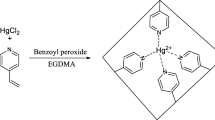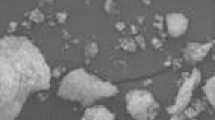Abstract
A new Pb(II)-imprinted amino-functionalized silica gel sorbent was synthesized by an easy one-step reaction by combining a surface imprinting technique for selective solid-phase extraction of trace Pb(II) prior to its determination by inductively coupled plasma optical emission spectrometry. The Pb(II)-imprinted amino-functionalized silica gel sorbent was characterized by Fourier transform infrared spectroscopy. Compared to non-imprinted polymer particles, the ion-imprinted polymers had higher selectivity and adsorption capacity for Pb(II). The maximum static adsorption capacity of the ion-imprinted and non-imprinted sorbent for Pb(II) was 19.66 and 6.20 mg g−1, respectively. The largest selectivity coefficient of the Pb(II)-imprinted sorbent for Pb(II) in the presence of Cd(II) was over 450. The relative selectivity (α r) values of Pb(II)/Cd(II) were 49.3 and 46.3, which were greater than 1. The distribution ratio (D) values of Pb(II)-imprinted polymers for Pb(II) were much larger than that for Cd(II). The detection limit (3σ) was 0.20 μg L−1. The relative standard deviation was 2.0% for 11 replicate determinations. The method was validated for the analysis three certified reference materials (GBW 08301, GBW 08504, GBW 08511), and the results are in good agreement with standard values. The method was also successfully applied to the determination of trace lead in plants and water samples with satisfactory results.




Similar content being viewed by others
References
Hultberg B, Andersson A (1998) Alterations of thiol metabolism in human cell lines induced by low amounts of copper, mercury or cadmium ions. Toxicology 126:203
Antochshuk V, Jaroniec M (2002) 1-Allyl-3-propylthiourea modified mesoporous silica for mercury removal. Chem Commun 3:258
Çay S, Uyanık A, Özaşık A (2004) Single and binary component adsorption of copper(II) and cadmium(II) from aqueous solutions using tea-industry waste. Sep Purif Technol 38:273
Liu CH, Yi YL, Zhang DG, Zhu HG, Yang Y (2003) Cadmium pollution of soil in the surrounding area of Huludao zinc plant. Chin J Soil Sci 34:326
Ikeda KJ, Abe SK (1998) Liquid–liquid extraction of cationic metal complexes with p-nonylphenol solvent: application to crown and thiacrown ether complexes of lead (II) and copper (II). Anal Chim Acta 363:165
Mahmoud ME, Osman MM, Amer ME (2000) Selective pre-concentration and solid phase extraction of mercury(II) from natural water by silica gel-loaded dithizone phases. Anal Chim Acta 415:33
Abou-El-Sherbini KS, Kenawy IMM, Hamed MA, Issa RM, Elmorsi R (2002) Separation and preconcentration in a batch mode of Cd(II), Cr(III, VI), Cu(II), Mn(II, VII) and Pb(II) by solid-phase extraction by using of silica modified with N-propylsalicylaldimine. Talanta 58:289
Ghiasvand AR, Ghaderi R, Kakanejadifard A (2004) Selective preconcentration of ultra trace copper(II) using octadecyl silica membrane disks modified by a recently synthesized glyoxime derivative. Talanta 62:287
Pyrzyñska K, Trojanowicz M (1999) Functionalized cellulose sorbents for preconcentration of trace metals in environmental analysis. Crit Rev Anal Chem 29:313
Vassileva E, Proinova I, Hadjiivanov K (1996) Solid-phase extraction of heavy metal ions on a high surface area titanium dioxide (anatase). Analyst 121:607
Jal PK, Patel S, Mishra BK (2004) Chemical modification of silica surface by immobilization of functional groups for extractive concentration of metal ions. Talanta 62:1005
Buszewski B, Jezierska M, Welniak M, Berek D (1998) Survey and trends in the preparation of chemically bonded silica phases for liquid chromatographic analysis. J High Resolut Chromatogr 21:267
Matoso E, Kubota LT, Cadore S (2003) Use of silica gel chemically modified with zirconium phosphate for preconcentration and determination of lead and copper by flame atomic absorption spectrometry. Talanta 60:1105
Liu R, Liang P (2008) Determination of trace lead in water samples by graphite furnace atomic absorption spectrometry after preconcentration with nanometer titanium dioxide immobilized on silica gel. J Hazard Mater 152:166
Goswami A, Singh AK (2002) 1,8-Dihydroxyanthraquinone anchored on silica gel: synthesis and application as solid phase extractant for lead(II), zinc(II) and cadmium(II) prior to their determination by flame atomic absorption spectrometry. Talanta 58:669
Makote RD, Dai S (2001) Matrix-induced modification of imprinting effect for Cu2+ adsorption in hybrid silica matrices. Anal Chim Acta 435:169
Dickert FL, Hayden O (2002) Bioimprinting of polymers and sol–gel phases. selective detection of yeasts with imprinted polymers. Anal Chem 74:1302
Dai S, Burleigh MC, Ju YH, Gao HJ, Lin JS, Pennycook SJ, Barnes CE, Xue ZL (2000) Hierarchically imprinted sorbents for the separation of metal ions. J Am Chem Soc 122:992
Sulitzky C, Rückert B, Hall AJ, Lanza F, Unger K, Sellergren B (2002) Grafting of molecularly imprinted polymer films on silica supports containing surface-bound free radical initiators. Macromolecules 35:79
Shea KJ, Sasaki DY (1989) On the control of microenvironment shape of functionalized network polymers prepared by template polymerization. J Am Chem Soc 111:3442
Liu YW, Chang XJ, Wang S (2004) Solid-phase extraction and preconcentration of cadmium(II) in aqueous solution with Cd(II)-imprinted resin (poly-Cd(II)-DAAB-VP) packed columns. Anal Chim Acta 519:173
He Q, Chang XJ, Wu Q, Huang XP, Hu Z, Zhai YH (2007) Synthesis and applications of surface-grafted Th(IV)-imprinted polymers for selective solid-phase extraction of thorium(IV). Anal Chim Acta 605:192
Zhai YH, Liu YW, Chang XJ, Chen SB, Huang XP (2007) Selective solid-phase extraction of trace cadmium(II) with an ionic imprinted polymer prepared from a dual-ligand monomer. Anal Chim Acta 593:123
Chang XJ, Jiang N, Zheng H, He Q, Hu Z, Zhai YH, Cui YM (2007) Solid-phase extraction of iron(III) with an ion-imprinted functionalized silica gel sorbent prepared by a surface imprinting technique. Talanta 71:38
Bae SY, Zeng X, Murray GM (1998) Photometric method for the determination of Pb2+ following separation and preconcentration using a templated ion-exchange resin. J Anal At Spectrom 13:1177
Daniel S, Gladis JM, Rao TP (2003) Synthesis of imprinted polymer material with palladium ion nanopores and its analytical application. Anal Chim Acta 488:173
Rao TP, Daniel S, Gladis JM (2004) Tailored materials for preconcentration or separation of metals by ion-imprinted polymers for solid-phase extraction (IIP-SPE). TrAC Trend Anal Chem 23:28
Ensing K, Boer T (1999) Tailor-made materials for tailor-made applications: application of molecular imprints in chemical analysis. TrAC Trends Anal Chem 18:138
Laxen DPH, Harrison RM (1981) Cleaning methods for polythene containers prior to the determination of trace metals in fresh water samples. Anal Chem 53:345
Miranda Carlos ES, Reis BF, Baccan N, Packer AP, Gine MF (2002) Automated flow analysis system based on multicommutation for Cd, Ni and Pb on-line pre-concentration in a cationic exchange resin with determination by inductively coupled plasma atomic emission spectrometry. Anal Chim Acta 453:301
Han DM, Fang GZ, Yan XP (2005) Preparation and evaluation of a molecularly imprinted sol–gel material for on-line solid-phase extraction coupled with high performance liquid chromatography for the determination of trace pentachlorophenol in water samples. J Chromatogr A 1100:131
Fang GZ, Tan J, Yan XP (2005) An ion-imprinted functionalized silica gel sorbent prepared by a surface imprinting technique combined with a sol–gel process for selective solid-phase extraction of cadmium(II). Anal Chem 77:1734
Miller JC, Miller JN (1984) Statistics for analytical chemistry. Ellis Horwood, New York, pp. 56
Author information
Authors and Affiliations
Corresponding author
Electronic supplementary material
Below is the linked to the electronic supplementary material
Table S1
Competitive loading of Pb(II) and Cd(II) in 50 ml solutions by 30 mg Pb(II)-imprinted and 30 mg non-imprinted silica gel sorbent (DOC 33.5 kb)
Table S2
Effect of foreign ions on percent recovery of 1.0 μg mL−1 Pb(II) on the sorbent followed by elution with 2.0 mL 1.0 mol L−1 HCl (DOC 34.5 kb)
Rights and permissions
About this article
Cite this article
Zhu, X., Cui, Y., Chang, X. et al. Selective solid-phase extraction of lead(II) from biological and natural water samples using surface-grafted lead(II)-imprinted polymers. Microchim Acta 164, 125–132 (2009). https://doi.org/10.1007/s00604-008-0045-y
Received:
Accepted:
Published:
Issue Date:
DOI: https://doi.org/10.1007/s00604-008-0045-y




